|
As an icon of the Italian western, Sabata both conforms to expectations and confounds them a little. He dresses in black and wears a distinctive hat, is a lightning-fast crack shot (of course) and has a small collection of signature weapons. Where he differs from the likes of Clint Eastwood’s The Man with No Name, Charles Bronson’s Harmonica and even Franco Nero’s Django, is that far from being a moody or taciturn figure, Sabata is rather easy-going and seems to derive a degree of amusement from his actions and the foolishness of others. I can’t help thinking that he trained to be as good as he is simply because it looked like it might be rather fun to be a gunfighter.
It’s indicative of the time in the Italian western cycle in which these films were made that while Sabata’s weapons of choice do have a basis in reality, what he is able to do with them throws credibility to the four winds. In the first film, his favoured weapon for long range kills is a Winchester rifle onto which he is able to fit an extended barrel, allowing him to make insanely accurate shots from impossible distances. For closer quarters shooting, he prefers a four-chamber Derringer that can be pulled out of nowhere and used to disable or kill an opponent before they realise what’s happening. I won’t get into the difficulty of making an accurate shot over any distance with a short-barrelled pocket pistol, but Sabata can shoot a button off the shoulder of a jacket or split the string on a banjo from the other side of a large room without even taking aim. This gun also has three extra chambers hidden in the handle that Sabata can make accurate shots with whilst pointing the pistol skyward. Then again, Sabata isn’t a real-world gunfighter, he’s a super(anti)hero, a James Bond of the West. And the reality-stretching doesn’t stop there. No sir.
In some ways, Sabata is a composite of previous Italian western icons. The influence of the previous year’s If You Meet Sartana... Pray for Your Death is most keenly felt, from the similarity of the titular gunslingers’ names to their black attire and the fact that they both use a custom-made, four-chamber Derringer pistol. There seems little doubt that Lee Van Cleef’s roles as Colonel Mortimer in For a Few Dollars More and Sentenza in Sergio Leone’s 1966 The Good, the Bad and the Ugly were a key influence on the casting of Lee Van Cleef in the titular role, but it fits him like a black leather glove and he makes it his own as soon as he appears on screen. So why, you might wonder, was he replaced then by Yul Brynner, who not only looked nothing like Van Cleef but delivered a different spin on the character? Well, that’s because the second film in the trilogy, Adiós, Sabata, was not originally intended as a Sabata film at all, but was retitled as one for the worldwide market to cash in on the international success of the first film. I’ll get to its wonderful original title when I talk more specifically about that film. The third film in the trilogy, The Return of Sabata, saw Van Cleef reprise the role in what is technically the second film of a duology. Got that? All three films were written and directed by Gianfranco Parolini under the more American sounding pseudonym of Frank Kramer, and if that has a familiar ring then that’s because he also co-wrote and directed the aforementioned If You Meet Sartana... Pray for Your Death. Aha, now it all starts to make sense…
The introduction of Sabata is, I suspect, deliberately designed to play games with our expectations for the sort of man he will be. In the western town of Daugherty City, the army locks a record sum of $100,000 inside a serious-looking strongbox in the town’s bank, then posts armed guards inside and outside of the building to make sure that no bandits try to break in and steal it. A short while later, a group of bandits break in and steal it. Hang on, I’m getting ahead of myself. The money is locked away, and as the title sequence unfolds, someone rides slowly into town. His identity is initially concealed by the filmmakers, first by presenting his arrival solely from his viewpoint as the army guards motion him to move on as he passes the bank, then by keeping the camera pointed his feet as he dismounts and walks towards the saloon. It’s then that we meet scruffy rogue Carrincha (Ignazio Spalla, credited throughout the series as Pedro Sanchez) as he’s hurled into the street, where he sits and complains about his treatment to Indio (Aldo Canti), who is watching him silently from a rooftop above. Carrincha seems especially bitter that his actions in a Civil War battle for which he was decorated do translate into the respect that he believes he deserves (this comes up a lot), though the reason for his ejection from the saloon seems to be down more to his current inability to pay for his drinks. When the town’s mysterious new arrival reaches him, he stops and flicks a silver dollar into his hand, and finally we get to see the face of the man we already know full well is Sabata.
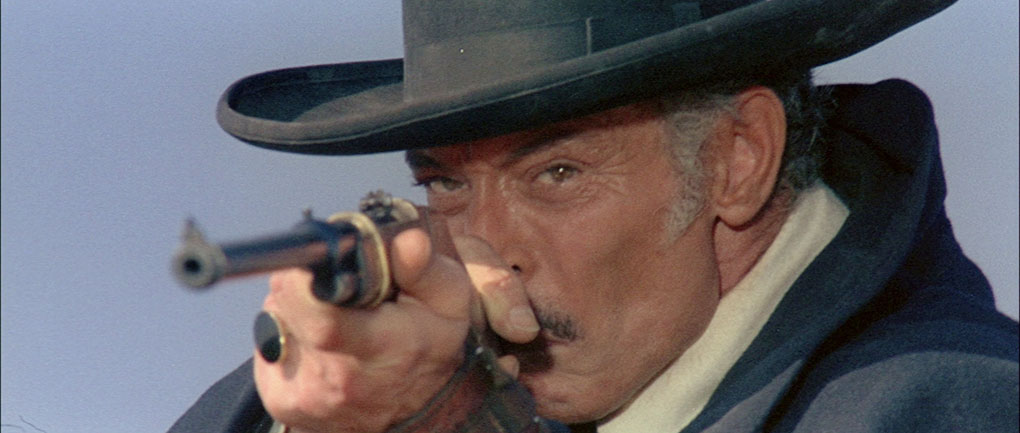
As Sabata walks into the lively saloon, closely followed by the newly flush Carrincha, the aforementioned bandits are covertly approaching the bank, and I have to say their plan is both ingenious and executed with panache. Guards are taken out individually and silently with throwing knives, while a recruit from a group of travelling players gains acrobatic access to the upper floor and sorts the guards out there. The barred doors blocking access to the safe are pulled off their hinges by a team of horses, and the strongbox is hauled out on a wheel base that is pulled along a specially cut section of rail and loaded straight onto horse-drawn cart outside. As it plays out on screen, it looks a lot more plausible than it probably reads.
Sabata, meanwhile, gives a demonstration of his skills and his dislike of cheats by shooting a loaded dice in half and winning some money for a player who was being fleeced by the dealer, then flips a coin into the pianola and takes his leave. As he passes the bank, he sees the aftermath of the robbery but elects to say nothing and ride on. At this point it’s hard to gauge what his intentions are, but we soon find out when he catches up to the gang, commands them to turn back and then shoots every one of them from a distant hilltop for failing to comply. But instead of stealing the money for himself as expected, he jumps on the cart and rides it back to Daugherty, arriving just as the leader of a group of soldiers that had been tasked with locating the robbers is reporting that they couldn’t find them anywhere. How hard did they look? Sabata found them in no time at all. Anyway, as the townspeople gather around the bank to gawk, some barely disguised smug looks clue us in to who was really behind the robbery. Three already well-to-do individuals are revealed to be in cahoots in the shape of Judge O’Hara (Gianni Rizzo), businessmen Ferguson (Antonio Gradoli), and Stengel (Franco Ressel), an almost comically effete dandy whose weapons of choice are duelling pistols and a cane with silver ram’s head tip that is capable of firing a lethal dart. I bet we’ll be seeing more of that fellow later.
It comes as no surprise that Sabata soon has an uninvited sidekick in the shape of Carrincha, an opportunistic hanger-on whose hidden talent is the ability to pull a knife from a sheath under his collar and target it as accurately as Sabata’s bullets. Also joining the team is the above-mentioned Indio, a mute acrobat of spectacular skill whose powerful physique and distinctive looks see him effortlessly eclipse everyone else as soon as he walks or jumps or bounces on screen. He’s also the character I found myself caring about the most, being loyal to a fault and willing to put himself at great risk to help put Sabata’s plans for sabotage and intimidation into action. Hovering constantly on the periphery, meanwhile, is Banjo (an effortlessly charismatic William Berger), who seems to spend much of the first half sizing up Sabata, with whom he has a bit of history and whose firearm skills he can seemingly match with his own cleverly concealed weapon.
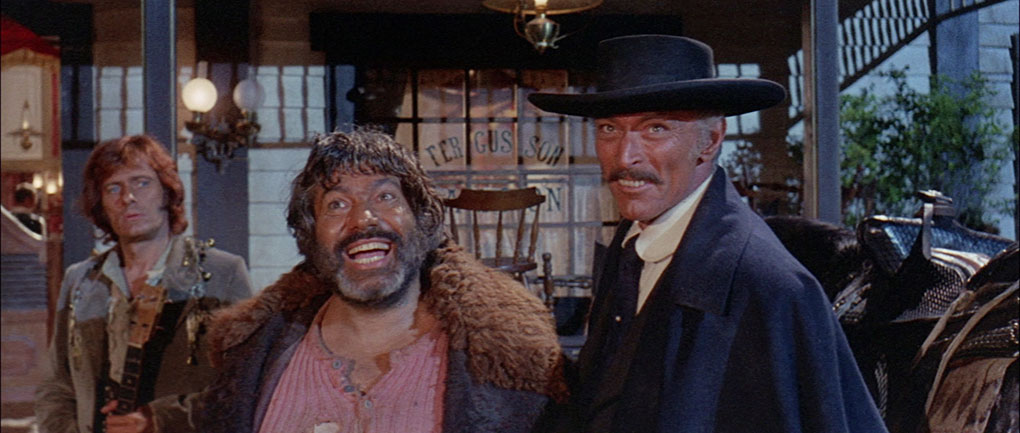
As is often the way with Italian westerns of the period, Sabata is primarily motivated by the pursuit of cash, but is unusually picky about from where and whom he takes it, returning the stolen money and then extorting the trio of corrupt capitalists who arranged its theft in the first place. There’s a message for us all there. The gunfights are shot and edited with the expected whizz-bang aplomb, and while there’s never really a sense that Sabata is going to be outgunned by anyone, the subtly self-satisfied smile that sneaks onto his lips when he disposes of his challengers – one of whom I actually felt rather sorry for – is does emphasise not just that he’s the best there is, but also that he knows it. This does, however, impact on the credibility what was doubtless designed to be a late-film surprise that was rendered inert anyway by the arrival of two sequels. Overall, it’s an entertaining, smartly-made addition to a subgenre of the western that has its own codes and conventions and whose best works are amongst the most stylish that the genre has to offer. So where, you might wonder, would the character go from here? Ah…
As I mentioned above, the second Sabata film was not originally intended to be a Sabata film at all, but a stand-alone work featuring a new gunslinger named Indio Black, a moniker I have to admit to rather liking. I also have a fondness the original, typically over-expressive Italian title, Indio Black, sai che ti dico: Sei un gran figlio di..., which apparently translates as Indio Black, you know what I'm going to tell you... You're a big son of a.... Then, sometime during this film’s production or after its Italian release (accounts and evidence tend to vary), the decision was made to release it internationally as a sequel to Sabata, primarily to trade on the success of the earlier film. So Indio Black is now Sabata. It’s just…
He’s not Sabata, okay? I’m sorry, I tried, but having watched this second film in the trilogy so shortly after the first, I was never at any point able to picture Indio Black as the antihero of the first film. Apart from the fact that they both dress in black and are both crack shots with specialist weapons, they have little in common. Sabata has silver hair and a moustache and dresses like a professional gambler, while Indio is bald and clean-shaven and dresses more casually, with the open-front shirt and medallion look of a tourist on the pull on the Costa del Sol. Sabata uses a Winchester with an extended barrel attachment for long-distance shots that he aims with care, while Indio has a short-barrelled rifle with a side-loading cartridge that he tends to fire from the hip. For close-range shots, Sabata has a custom four-chamber Derringer with concealed backup barrels in the handle, while Indio tends to still favour his rifle, though at a push will whip out a standard two-chamber Derringer to finish the job. And while Sabata appears faintly amused by everything he does, Indio tends to take his work more seriously and even lacks his predecessor’s distinctive hat. Oh, and Indio’s signature move is to pull a cigar from the last chamber of his rifle’s handsomely engraved repeater cartridge to smoke after he has finished, erm, smoking his opponents. Van Cleef’s Sabata just seemed to stifle his amusement. There was never any question in my mind that Sabata and Indio are completely different people, but if you can ignore the fact that everyone calls him Sabata when we all know that his name is really Indio Black (oh, I do like that), then Adiós, Sabata has plenty going for it.
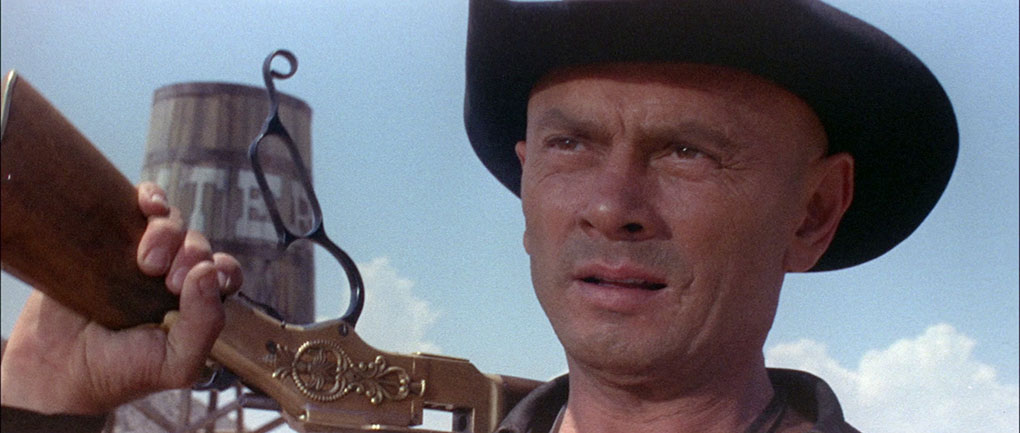
One thing I did learn from this film, from Mike Siegel’s commentary and from the research that it prompted is that for a four-year period between 1864 and 1867, Mexico was ruled by Austrian Emperor Maximilian I. It’s a reign that came to a conclusive end when he was executed by firing squad after his government was overthrown by revolutionary forces led by the country’s former president, Benito Juárez. Adiós, Sabata is rare, if not unique, in being set during the period of increasing instability that immediately preceded Maximilian’s demise. As a result, the principal villain here is Austrian district ruler, Colonel Skimmel, who is played by German actor Gérard Herter and occasionally has the look of a heavily moustachioed Patrick McGoohan. He establishes his bad guy credentials early on by using captured Mexican revolutionaries for target practice as they’re individually released below his balcony and encouraged to run for their freedom. The plot really kicks off when their still-at-large leader, Ocaño (the wonderfully named Franco Fantasia), hires Sabata for what we eventually discover is the theft of a shipment of Austrian gold, which he intends to use to help fund the revolution. To assist the gunslinger, Ocaño picks loyal revolutionary Escudo (Ignazio Spalla again, but in a different role), and presents him with three trustworthy individual to aid the mission, one of whom Escudo immediately exposes as a paid Skimmel spy. The only two men that Escudo truly trusts are Gitano (Turam Quibo, credited here as Joseph Persaud) and the mute Septiembre (Sal Borgese). Gitano’s principal job appears to be to perform a flamenco dance as a build-up to Escudo shooting someone, while Septiembre is able to incapacitate enemies with large ball-bearings launched from a specially crafted cleft in his shoe. In loose orbit around the whole operation is the opportunistic Ballantine (Dean Reed), someone with whom Sabata clearly has a history but clearly doesn’t trust enough to initially allow to join their operation.
Even before the story proper gets going, we’re given a demonstration of what Sabata Mk. IIis capable of when he agrees to take on the four Murdock brothers (whoever they are), and use the occasion to show us his skills with a rifle and that trick with his post-gunfight celebratory cigar. The watching Ballantine uses it to make a bit of money by being the only one of a gathered crowd who bets on the man in black. The unlikely accuracy of Sabata’s long-barrel shooting in the first film is taken to another level here, with Sabata Mk. II shooting without taking serious aim and with a gun whose short barrel would make its accuracy questionable over any real distance, but he still hits his target without fail every time. Even more unlikely is Septiembre’s ability to flick a small metal ball with his foot at the speed of a bullet with similar accuracy, but I enjoyed Sal Borgese’s portrayal of the character too much to get seriously critical, and as this particular gimmick gives the party a silenced weapon, it’s hard not to rather delight in its use. Ignazio Spalla may once again be cast as the a borderline stereotypical fat Mexican bandit, but it’s a role he excels and undeniably entertains in, while Dean Reed’s good looks and smilingly upbeat portrayal of Ballantine give the character echoes of the previous film’s Banjo, and it’s clear from an early stage that he’s no more trustworthy. As for Yul Brynner, he’s a picture of effortless cool, dressed how he was in his breakthrough role in The Magnificent Seven and as he would be later as the terrifying malfunctioning robot in Westworld, but this time with a lot more chest hair on display. He makes for a solid and engaging antihero, but for my money he’s just not as much fun as Van Cleef was in a role that he defined and was soon to return to.
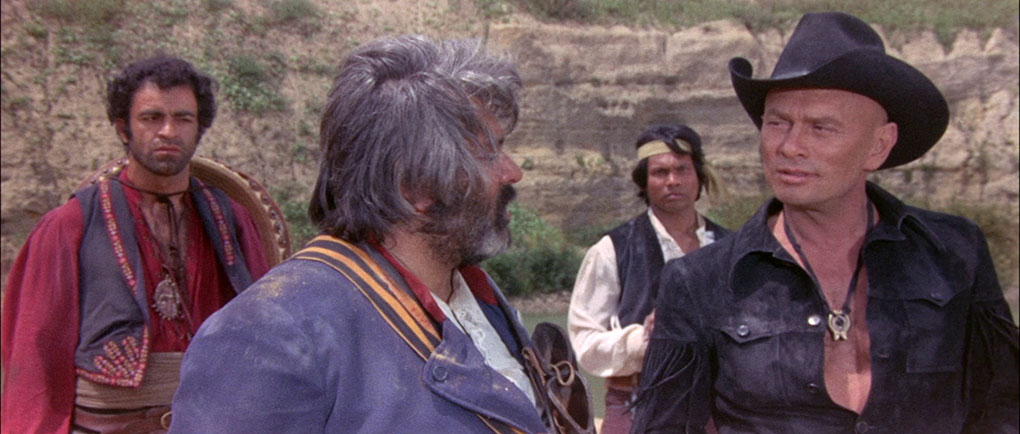
Adiós, Sabata is still a very enjoyable film that may start confusingly but does pack a lot of plot shenanigans into its running time and makes the most of what I was unsurprised to discover was a substantially larger budget than its forebear had to play with. It has its share of neat surprises, but can there be any seasoned movie devotee who, on catching their first site of the tall but rickety wooden bridge that links one side of a gorge to the other, doesn’t know full well that sooner or later will be blown to smithereens? It’s to the film’s credit that it gives you only a few seconds to realise this before providing concrete confirmation of the explosion to come.
I can’t help thinking that the title of this third film, as well as being standard fare for a western sequel, is referencing the fact that it marks the return of Lee Van Cleef to a role that he helped to define. It also has a few small nods to the second film (whose title also could read as a comment on Van Cleef’s temporary absence), in the speed and density of its plotting, in a lyric in the hilarious but infuriatingly catchy theme song, and in a late film sequence in which Sabata appears without a tie and with his shirt front open. Yul Brynner, fashion style setter. But I digress.
Following a brief teaser for later intrigue, Return of Sabata gets under way in curious fashion and then gets more curious still. After several identically dressed gunfighters appear before a committee of suited judges in what looks like a small barn, they proceed to use the location as a deathmatch arena. At first, they appear to be focussed on killing each other, with every death marked on a score sheet by one of the judges, but once Sabata enters the arena, all guns are immediately turned on him. Of course, Sabata outwits and outshoots them all, then a door bursts open and a circus clown bounces in and announces jovially, “The grand finale of the show! Bing! Boom!” Excuse me? What? The fallen gunslingers then get to their feet and dab at the fake blood as appreciative members of the audience file in and congratulate them. Where, I wondered, in this enclosed location, were these people seated while this performance was taking place? Sabata, it would appear, has joined a circus and is now using his skills with a handgun to entertain the general public. Oh, how the mighty have fallen.
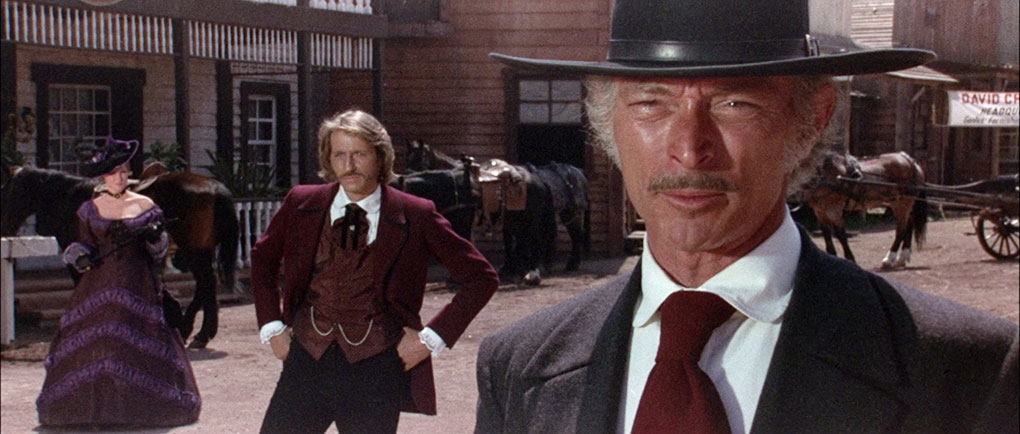
That’s certainly what Clyde (Reiner Schöne) thinks when he sees Sabata perform. Clyde, it turns out, served as a lieutenant under Sabata in the Confederate Army during the Civil War and cannot believe that the man who was once his superior officer has been reduced to making a living as a sideshow performer. At least that’s what he claims. Given that he owes Sabata $5,000 that he lost to him some time ago at poker and has still not repaid, there may just be another reason why he scuttled away so quickly after catching sight of his former commander. The circus is currently visiting the Texas town of Hobsonville, whose gambling house is run by Clyde and whose use of magnets to cheat customers out of their money at roulette is quickly sussed and turned around on the house by Sabata. Effectively running the town is Joe McIntock, the head of a large Irish family that works for the progress and development of the area. On the surface, at least, his intentions seem to be in the right place, with taxes imposed on the sale of goods to raise money for a range of new constructions, including a railroad station, a museum, a bank, and the biggest and best hospital in in the state. We’re steered early on to see McIntock as a bad guy, but is he really? His tax and build scheme certainly appears to be popular with the locals, and when Sabata refuses to pay these additional fees, he does seem to play to the stereotype of the tax and government-hated southerner, and inadvertently aligns himself with the tax-dodging fat-cat scumbags of today. There is, of course, somewhat more to this than these benevolent surface impressions suggest. Could it be related to an opening sequence in which a grey-haired man is observed by an unknown figure hurriedly removing a sizeable amount of cash from beneath the floorboards of a caravan?
Familiar faces from the earlier films make second and third appearances here. McIntock’s brother-in-law is played by Gianni Rizzo, who played Judge O'Hara in Sabata and a minor character named Folgen in Adiós, Sabata. Ignazio Spalla is also back again as Bronco, who is without question the film’s most initially bemusing character. He (literally) bangs the drum for McIntock and publicly chastises Sabata for refusing to pay the town taxes, yet a short while later is driving him around in his buggy and siding with him against the man he was previously so supportive of. Also back – hoorah! – is Aldo Canti as Angel, an acrobatic and relentlessly cheerful pickpocket in Clyde’s employ, who together with his partner, Bionda (Vassili Karis), go from robbing Sabata to assisting him after he gives them some of the cash that they lifted from him because, “You guys are pretty good!”
Return of Sabata combines the fun of the first film with the busy plotting of the second and runs riot with notions of dishonesty and deception, particularly in the shape of the slippery Clyde, who over the course of the story double-crosses almost everyone in the film. Sabata still relies of his four-chamber Derringer with its surprise in the handle, but has abandoned his long-barrelled rifle in favour of a circular pistol that can be concealed in the palm of his hand, a weapon I initially scoffed at but that a bit of research revealed was based on a real custom gun known as the Minneapolis Protector. Colour me impressed. That said, the film’s best weapon is not wielded by Sabata but Angel’s partner Bionda, a large and powerful catapult that he hooks over both feet and lies on his back to fire. Like the roundhouse-kick missiles thrown by Septiembre in Adiós, Sabata, this has the advantage of silent delivery, but it’s accuracy and potential lethality are more convincingly sold, while its usage is shot and edited with a whack that really emphasises its power and the impact of its projectiles.

The case is made in the special features for Return to Sabata as the lightest in tone of the trilogy (we’re something like two-thirds of the way into the film before the on-screen death) and a film that marked the midway point of the ongoing transition from the more serious Italian westerns of preceding years to more comedically toned Trinity films and their ilk. It certainly presents Sabata in a slightly more human light, giving him a whisper of a back story and even a girlfriend in the shape of Bordello girl Maggie (Annabella Incontrera), a rare female character of note in this very male series. Handsomely shot in scope by series regular Sandro Mancori, this is another enjoyable and inventive ride for a borderline comic-book gunslinger and the engaging troupe of misfits that he attracts. It also feels as good a point as any for Van Cleef and director Gianfranco Parolini to put the series to bed and move on to other projects. Many films would follow that witless fools in marketing departments would try to sell as further Sabata sequels, but none had the characters, the plot complexity or the smart surface sheen that makes this trilogy so entertaining and oddly satisfying.
All three films are framed in their original aspect ratio of 2.35:1, have clearly been restored, and have been encoded at a seriously high bitrate, and the results tend to reflect that. At its best – and Return of Sabata tends to shine brightest here – the image is in excellent shape, with crisply defined detail that shines brightest in close-ups of faces and weaponry, although a handful of wider shots – most visible in Adiós, Sabata – are noticeably softer. The well-balanced contrast of the first film does get just a tad punchier as the series progresses, but the solid black levels never seriously punish the shadow detail. Colour is attractively rendered throughout and genuinely vibrant when brighter hues put in an appearance, something that is once again most effectively showcased in the final film. Although generally clean, the transfers are just a notch shy of pristine on this front, with a few small dust spots still visible and a very brief but larger blob of dirt on Sabata. Occasionally, a shot-long sliver of dirt or hair can be seen at the top or bottom of frame that was likely caught in the gate of the camera and would thus be on the original negative – a more thorough (and expensive) restoration might see these removed. More curious are the single small bright spots that appear on both Adiós, Sabata and Return of Sabata and hang around for about ten minutes, the rough length of a reel of projected film. They’re not a serious distraction, but sitting in one spot as they do (in different places on each), they had me checking my TV for misbehaving pixels.
The Linear PCM 2.0 dual mono soundtrack has the anticipated restrictions in its dynamic range, but the dialogue is always clear and the signature Italian western gunshot sounds have the hoped-for (if high-pitched) kick. Music tends to fare slightly better, but unsurprisingly still lacks the richness of Dolby-era orchestral soundtracks. It's worth noting that the Italian soundtracks have not been included here, but the English track is a comfortable fit given the American leads and co-stars.
Optional English subtitles are available for all three films.
SABATA
Audio Commentary by Barry Foreshaw and Kim Newman
You can generally be sure that if critic and novelist Kim Newman is involved in a commentary, it’s going to be packed to the gills with information and probably rather fun, an approach confirmed at the start of this one when Newman provides his own take on the MGM lion growl. Here he’s teamed with Italian cinema expert Barry Foreshaw, and between them they cover a huge amount of ground, with particular focus on the man with the gunsight eyes, Lee Van Cleef. Other topics covered include the importance of Sergio Leone to the international popularity of Italian westerns, the gimmicks and weapons of the Sabata films, the supporting characters, director Gianfranco Parolini (aka Frank Kramer), acrobatic actor Aldo Canti, the score and theme song, the genre’s often striking cinematography, the post-dubbing of Italian movies, and much more. The fact that the second film was not originally intended as a Sabata movie is discussed, and Foreshaw sums the appeal of this first film by describing it as, “ridiculous, absurd, but great fun.”
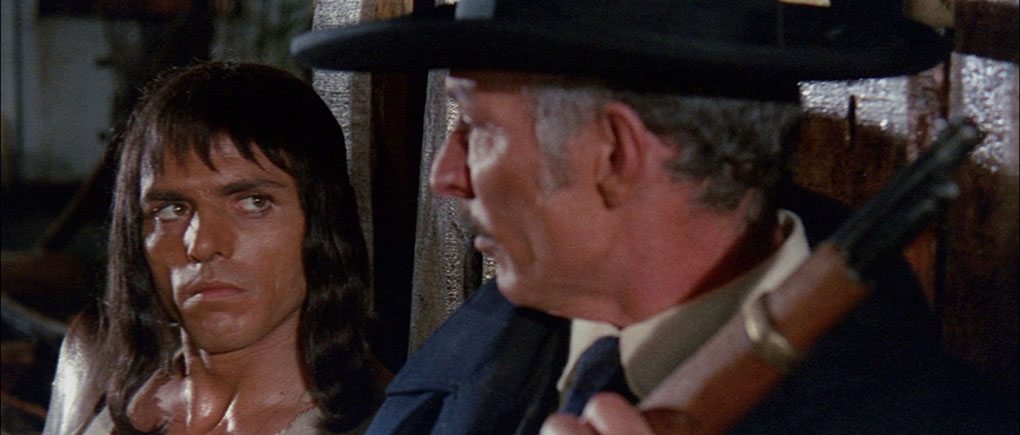
Austin Fisher on Sabata (11:02)
Author of Radical Frontiers in the Spaghetti Western, Austin Fisher, discusses Sabata in relation to the genre conventions it follows and the elements that make it stand out from its contemporaries, as well as its place in the development of the Italian western as it evolved into something more comic and parodic. Particularly interesting are the parallels he draws between this film and the Sam Raimi’s The Quick and the Dead and Robert Rodriguez’s Once Upon a Time in Mexico, and his comments on its almost sanitised approach to violence when compared with the Hollywood westerns of the day. Fisher really knows his subject and is a good communicator – I could easily have listened to him talk on this for longer. Happily, there’s more from him on the other two discs in this set.
Promoting Sabata (7:07)
A rolling gallery of posters, lobby cards, production stills, campaign book pages and press materials from a range of countries, plus the Japanese soundtrack LP sleeve, all set to the music from the film, including a German version of the theme song. This was assembled by Mike Siegel, who provides the commentary on Adiós, Sabata.
Theatrical Trailer (1:37)
An oddball mix of action footage, still frames and graphics that wouldn’t be out of place in Roger Corman’s The Trip. I have a feeling this would get me into the cinema just to see what the hell the film it’s promoting could possibly be like.
ADIOS, SABATA
Audio Commentary by filmmaker Mike Siegel
Film historian Mike Siegel, whose work documenting the films of Sam Peckinpah I’ve previously saluted and continue to admire, tackles a film whose plot setup he admits he was confused by on his first two viewings, which did make me feel better about being similarly baffled on my first. He does cover a lot of ground here, but is particularly interested in the life and work of American actor Dean Reed, a committed socialist who lived in Chile, Argentina and East Germany, which made him a target of conservative hatred in America. Siegel spends about a third of the commentary talking about Reed, a man he clearly respects even more for his social conscience and commitment to causes than his dual careers as an actor and a successful singer. He does very occasionally labour the points he’s making, but there’s no question that Reed led a fascinating life and I found myself sharing Siegel’s admiration for the man and his personal politics, though do suspect that this may prove bit of a slog if all you came to this purely for info on the making of the film. And we do get that, with specifics on director Gianfranco Parolini (including why he was credited as Frank Kramer), producer Alberto Grimaldi, lead player Yul Brynner, the historical context against which the film is set, the supporting cast, the Sartana films that immediately preceded it, and plenty more.
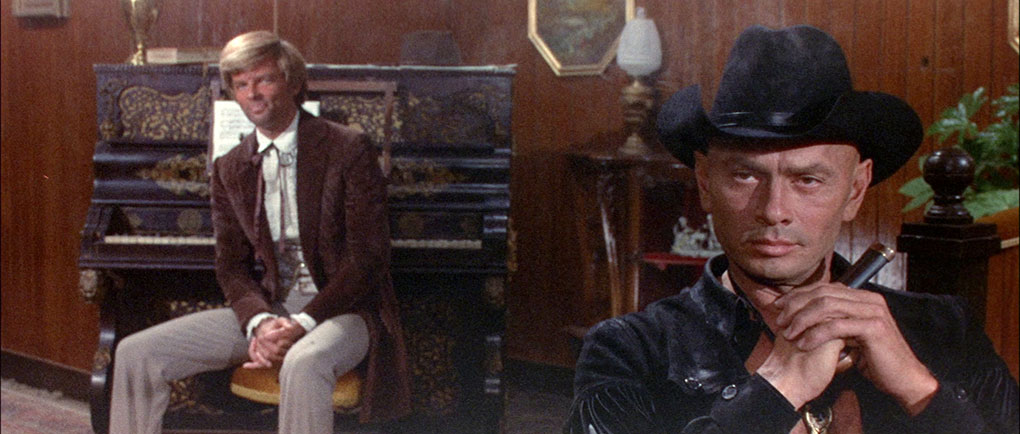
Austin Fisher on Adiós, Sabata (14:55)
Here, Austin Fisher turns his attention to the second film in the trilogy, one he confirms was originally released in Italy as an Indio Black film and marketed elsewhere as a Sabata title. He talks about the significance of its historical setting, the incorporation of Mexican border crossings into American westerns and how Italian westerns turned that trope on its head, the casting of Dean Reed, the links to Vera Cruz and The Magnificent Seven, and the condemnations thrown at the film for its violence, despite it being less bloody than its US counterparts of the day.
Promoting Adiós, Sabata (9:22)
Another of Mike Siegel’s rolling galleries of international promotional materials, which is assembled very much in the style of its predecessor. Included here are posters, lobby cards, monochrome and colour production stills, and press book pages, again set to music from the film. It includes Italian posters featuring the original title that identify Yul Brynner’s character as Indio Black.
Theatrical Trailer (2:04)
An American trailer narrated by someone who sounds terribly depressed at the very thought of someone like Sataba even existing, let alone doing what he does. Plenty of action is showcased, at one point with a lithographic look and an overlaid grid, a science fiction-like image that would be more at home on promotional material for Westworld.
RETURN OF SABATA
Audio Commentary by C. Courtney Joyner and Henry Parke
Novelist and screenwriter C. Courtney Joyner and the western film editor for True West magazine, Henry Parke, get stuck into the third film, but their considerable knowledge of the western and the Italian western subgenre sees them expand their analysis to cover a wide range of related works and genre trends. They talk about the influence of Italian giallo thrillers on the look of some scenes (this hadn’t occurred to me, but they’re absolutely right), the distinguished career of producer Alberto Grimaldi, the links between the first Sartana film and the Sabata trilogy, Van Cleef as a lighter and psychologically untortured western antihero, American actors who starred in Italian westerns, the multi-faceted role played by counterfeiting in this film, and much more. Another compelling and informative commentary.
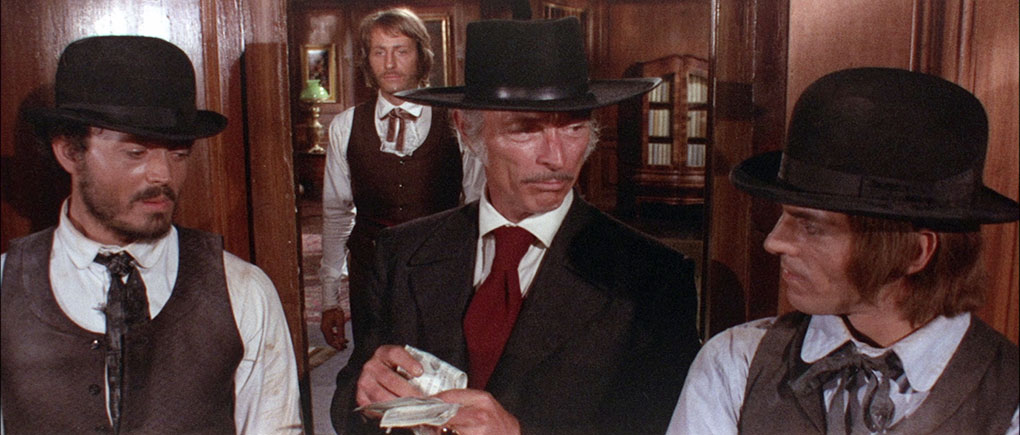
Austin Fisher on Return of Sabata (11:14)
Here Fisher talks about the evolution of Italian westerns, the film’s inventiveness, the development of Lee Van Cleef’s western persona, and how director Parolini plays with and frustrates audience expectations, including the genre-defying decision to have no-one die on screen for the first 75 minutes of the film.
Promoting Return of Sabata (7:42)
A third collection of international promotional materials from Mike Siegel, featuring posters, lobby cards, and production stills, all set to music from the film.
Theatrical Trailer (2:08)
An action-packed sell that spoils a few of the surprises that Sabata pulls on his foes, so I’d give this a miss until after the film, even though that does defeat the original purpose of a trailer.
PLUS
Booklet
Unusually, there are just two essays in the booklet that accompanies this release, the first on director Gianfranco Parolini, the second on the Sabata trilogy, both by Howard Hughes, the respected writer on Italian westerns, not the late germophobic billionaire. Both are terrific, going into considerable detail and making for most educational and enjoyable reading, particularly for someone who is not fully versed in the Parolini’s work, like myself. If the films themselves hadn’t already achieved this goal, these essays would definitely make me want to see more of this director’s output. The main credits for both films have also been included, as have the usual notes on viewing for anyone who still hasn’t set their TV up correctly.
An entertaining, smartly made and engagingly cast and played trilogy of Italian westerns, lighter in tone than many of the more famous genre films that preceded it but not as comical as the ones that were already starting to find an international audience. It’s great to have all three films in one set with such fine HD transfers and backed up by a decent collection of special features, including three excellent commentaries and a booklet built around compelling essays on the films and their director. Italian western devotees will have had this pre-ordered, but for anyone who hasn’t yet taken picked this set up it comes warmly recommended.
|